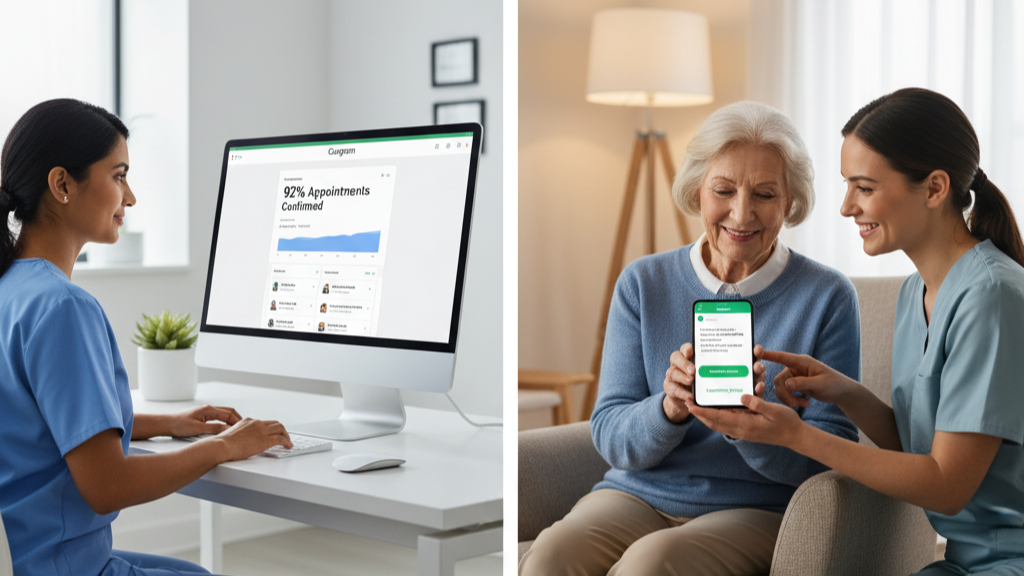What Is Patient Engagement in Healthcare (and Why It Matters)
💡Patient engagement in healthcare drives real outcomes. Patients who stay involved in their care are more likely to follow treatment plans. They...
7 min read
Gregory Vic Dela Cruz : 9/5/25 3:00 PM
.png)
Patients have more choices than ever when it comes to their healthcare. They can switch providers, leave online reviews, and compare clinics with a few clicks. In this competitive environment, medical outcomes alone are not enough. Experience is now a deciding factor that practitioners are laser-focused on. Especially since it directly impacts reputation, loyalty, and revenue.
So, what is patient experience in healthcare? Essentially, it is the full journey of interactions a person has with a clinic. It includes scheduling, wait times, communication, the quality of care, and follow-up. It’s not the same as patient satisfaction. Satisfaction measures how happy a patient felt. Experience on the other hand, measures what actually happened during their care.
This article aims to cover the following bases:
We’ll also explain how eCW users can use Curogram to deliver smoother, safer, and more connected care.
Patient experience refers to the sum of all interactions patients have with a clinic. This includes administrative processes like scheduling, communication touchpoints, the quality of care received, and post-visit follow-up. Patient satisfaction, in contrast, measures feelings—how happy or content a patient felt. Satisfaction is subjective; experience is based on measurable touchpoints. For example, a patient may be satisfied with a doctor’s kindness but still frustrated if wait times were long or billing was confusing. Understanding this distinction helps clinics focus on improving the actual journey, not just reported feelings.
The patient experience journey begins the moment a patient books an appointment. Was scheduling easy? Did the patient receive reminders? Was the check-in process smooth? During the visit, experience includes the clarity of communication, staff attentiveness, and the provider’s ability to explain treatment. Afterward, experience extends into follow-up instructions, billing, and whether patients can reach the clinic easily with questions. Each stage shapes how patients view the clinic and whether they’ll return or recommend it to others.
In the digital era, reputation spreads quickly. Patients share experiences in online reviews, social media, and word of mouth. A positive patient experience leads to loyalty and referrals. A negative one can damage a clinic’s reputation overnight. Experience also influences retention: patients who feel heard, respected, and supported are far more likely to keep returning. In short, the patient experience is no longer optional—it’s a business strategy that drives growth.
The importance of patient experience in healthcare shows up clearly in retention rates. Patients are more likely to return to clinics that treat them with respect, minimize wait times, and provide clear communication. Retaining patients costs less than acquiring new ones, so strong experiences are an investment in long-term loyalty.
Engaged patients are more likely to follow treatment plans, take medications correctly, and attend follow-ups. When patients feel supported through medical appointment text reminders, digital intake, and accessible communication, they’re more prepared and motivated. The result is improved outcomes for chronic disease management, preventive care, and recovery.
Today, reputation is built online. Patients search reviews before choosing providers. A positive scenario means patients don’t just feel happy—they have concrete, shareable stories of easy scheduling, attentive staff, and smooth follow-ups. These reviews help attract new patients organically.
Better patient experience means fewer no-shows, shorter visits due to prepared patients, and faster payment cycles. When clinics build trust through reliable communication and digital tools, patients respond by showing up, paying on time, and referring friends. In this way, patient experience isn’t just good care—it’s good business.
.png?width=1536&height=1024&name=what%20is%20patient%20experience%20in%20healthcare%20and%20why%20it%20matters%20-%20mid%20(1).png)
Distilled from the paper "Patient experiences: a systematic review of quality improvement interventions in a hospital setting" (2019) by Bastemeijer, et. al.
Long wait times are one of the top patient complaints. They affect how patients view the clinic, even if the medical care is excellent. Efficient workflows are essential for creating a positive patient experience.
Communication is one of the most important factors in improving patient experience strategies. Clear, respectful, and timely communication builds trust. Poor communication does the opposite.
Patients expect technology to simplify their healthcare. Modern patient experience trends in healthcare show that convenience matters as much as quality of care. Digital tools reduce stress and improve engagement.
Patients want to feel seen and heard. Personal touches and attentive staff interactions are critical. Experience improves when care feels tailored.
In addition to wait times, communication, tools, and personalization, several other factors influence the patient experience. These may seem small but they add up.
Each factor adds up to shape the full patient experience journey. A smooth check-in, attentive staff, and clear instructions may seem simple, but together they form a lasting impression. Poor execution in even one area can undo positive impressions elsewhere. That’s why clinics need to focus on the whole experience, not just isolated parts.
In short, the importance of patient experience comes from its impact on both patient trust and clinic performance. Every detail—wait times, communication, tools, and staff attentiveness—matters. Improving these areas strengthens retention, boosts revenue, and ensures better patient outcomes.
Paper-based forms and manual workflows slow down check-ins, frustrate patients, and increase errors. Modern clinics that replace clipboards with mobile digital intake improve efficiency and patient satisfaction instantly.
Calling patients for scheduling or reminders drains staff time and often fails to reach patients. Replacing calls with HIPAA-compliant texting improves engagement and frees staff for higher-value tasks.
Overworked staff cannot provide attentive, personalized care. Burnout reduces empathy and attentiveness, directly harming the patient experience. Automation helps reduce workloads and restores focus to patient needs.
Without consistent feedback, clinics miss opportunities to improve. Requesting reviews and sending surveys are strategies that ensure continuous growth.
Replacing paper forms with mobile-friendly intake reduces errors, speeds up check-in, and makes the patient journey smoother.
Automated appointment reminders help reduce no-shows, ensure better preparedness, and keep schedules full.
Secure messaging allows patients to ask questions, confirm visits, or reschedule without lengthy phone calls. This boosts convenience and trust.
Telehealth expands access, especially for rural or mobility-limited patients, aligning with modern patient experience trends.
Proactively asking for feedback shows patients their voices matter and gives clinics actionable data on how to measure patient experience.
A pediatric practice introduced digital intake forms that parents could complete from home. Check-in times dropped by 40%, and parents praised the convenience, improving the clinic’s reputation with families.
An imaging center began sending medical appointment text reminders with step-by-step prep instructions. Patients arrived more confident, scans ran on time, and staff reported fewer reschedules caused by miscommunication.
A multi-location provider adopted secure two-way texting to answer patient questions quickly. Response times improved, patient trust grew, and the clinics saw a measurable boost in loyalty and online reviews.
Curogram syncs seamlessly with eClinicalWorks. That means appointment reminders, digital intake, and patient messages all flow directly into the EMR. This keeps data accurate, reduces staff workload, and maximizes attendance rates.
Every interaction through Curogram is encrypted and audit-logged, ensuring HIPAA-compliant appointment reminders and SOC 2-level security. Clinics can communicate confidently without compliance risks.
Curogram unifies texting, intake, reminders, telehealth, and feedback collection. This all-in-one system empowers clinics to deliver faster communication, shorter wait times, and more personalized care. Clinics can communicate confidently without compliance risks.
Patient experience is the foundation of a clinic's success. It shapes outcomes, builds loyalty, and drives revenue. Patients judge their experience from the moment they book to the moment they pay their bill. Every touchpoint matters.
By knowing what patient experience is and why it's crucial, you can use strategies that work. Digital intake forms, automated reminders, HIPAA-compliant messaging, and telehealth aren’t mere conveniences. These digital tools have become indispensable for modern care. When paired with staff attentiveness and continuous feedback, they transform the care journey.
For eCW users, Curogram makes these improvements seamless. Its integration of messaging, reminders, and forms ensures smoother workflows and happier patients. Want to improve patient experience in your clinic? Get a free demo today.

💡Patient engagement in healthcare drives real outcomes. Patients who stay involved in their care are more likely to follow treatment plans. They...

Patient engagement has increasingly become more critical in every healthcare organization, from hospitals to small medical practices. So, how will...

Patient feedback is a critical factor in healthcare quality systems. It paves the way for transparency and accountability in healthcare. It’s about...